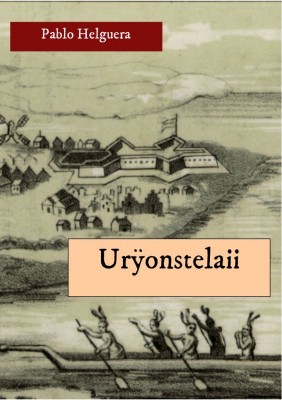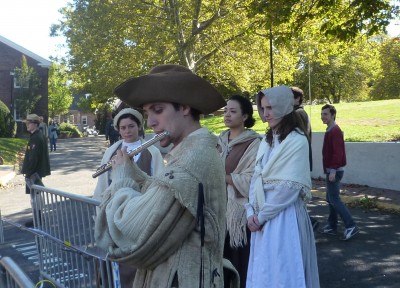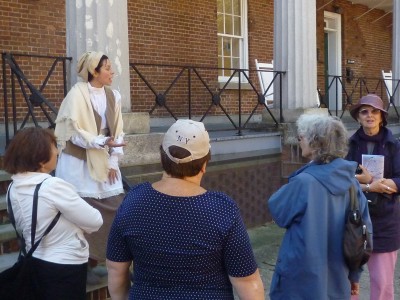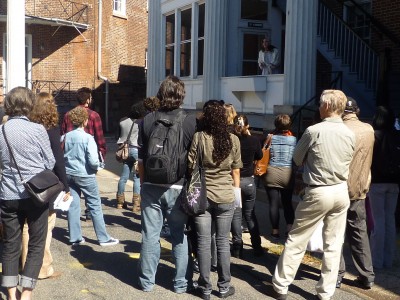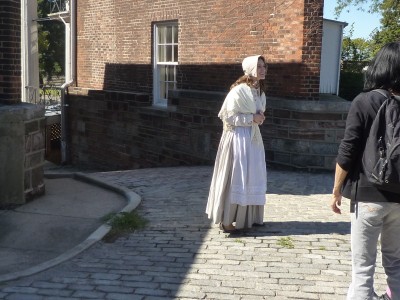Urÿonstelaii (2010)
In 1660, a mysterious sect of Dutch mystics arrived to an island in the New World with the objective to create a new society. Their governing principle revolved around the uninterrupted performance of a single dramatic work in seven tableaux vivants. Invoking alchemical imagery and hermetic thought, their goal was to arrive to a higher state of being by collectively embodying the symbolic representation of all of human and divine knowledge. Their experiment, which would last a century, would test the human boundaries of time, physical endurance, and the commitment of a society toward an idea.
Uryonstelaii is a project consisting of two complementary components: a book published by Jorge Pinto Books, New York, and a one-time only series of performed prologue tours delivered by historical reenactors. The contents of the performed prologue are not included in the publication and are not meant to be reproduced beyond their single performance.
The project was presented as part of The Sixth Borough, an exhibition at Governors Island in the summer of 2010 curated by Manon Slome and Julian Navarro for No Longer Empty.
“All history threads between what was and what could have been; all art threads between what is and what could be. In Urÿonstelaii, Pablo Helguera tugs at these threads, unraveling, reweaving, embroidering. The result is a strange and at times poignant tapestry of the possible, the dreamt, the present, and the lost.”
D. Graham Burnett, author of Trying Leviathan
“Like a ‘lamb in wolf’s clothing,’ Pablo Helguera uses the exoteric mechanisms of historical erudition to lure us to his magical island of the Ourobourians. But right about the time we lose our footing on the land’s slippery shores—when we begin to wonder if the artist has gleaned an esoteric tradition for more than just source material for his island’s symbols and nomenclature, when we start to navigate his land with the non-verbal hunches of the alchemists’ score, and call into question the artifices we employ to gather the world around us—we realize Helguera has really taken us on a journey to another land altogether, the most forbidden of places–the self.”
—Lise Patt, founder and director of the Institute of Cultural Inquiry, Los Angeles
Images from the “Prologue Tours” at Governors Island’s Fort Jay on October 2, 2010:
Excerpt from the beginning of the book:
In spring 1671, in Amsterdam, a mysterious book began to circulate among a small circle of intellectuals. Written in Latin and entitled Principia of the Live Image Method of the Ourobuorians, it provided a painstaking description of a single dramatic work consisting of seven elaborate tableaux vivants, one for each day of the week, to be performed in perpetuity on a remote island in the Americas. The instructional text, accompanied by obscure references and symbols, appeared to have been written for those already initiated into a society dedicated to the performance. It claimed that the continuous, collective presentation of the work would help participants attain transcendental knowledge that would lead “to the universal unveiling of the invisible threads that connect all the essences underneath every object.” The text’s millennial language and apparent fanaticism suggested that the author was a member of a northern European sect of Menonites or Pietists that, persecuted in its home country, had made its way to the Americas. And yet there was little, if any, mention of Christian rituals or beliefs.
Tableaux vivants had existed since the Middle Ages in presentations of liturgical dramas. In the Netherlands these were normally performed by groups specifically dedicated to this purpose, known as rederijkerskamers (“chambers of rhetoric”). These groups had emerged in the fifteenth century out of secular and spiritual brotherhoods in Flanders whose original mission had been to aid the clergy in the creation of religious processions and dramas. Rederijkerskamers had a strict order of membership and a very specific hierarchy (with titles such as Prince, Emperor, Dean, and Fool) and developed their repertoire mostly to participate in contests known as landjuwelen (“country jewels”), where they would showcase their dramatic achievements. They were experts at creating “wagon plays” with biblical or historical subjects and elaborate triumphal arches, which often served as theatrical sets with a variety of entrances and performing spaces.
Principia of the Live Image Method of the Ourobuorians appeared to be the product of a rather esoteric rederijkerskamer, one that had moved from the Netherlands to the Dutch settlement of New Amsterdam or had recently formed there. It was not unusual for members of rederijkerskamers to form societies there—such was the case of the famous Dutch playwright Joost van den Vondel, who fled religious persecution in Germany; they were merchants (such as Hendrik Laurenz Spieghel) and marine underwriters (Roemer Visscher). Some readers suggested that Principia was the product of a splinter group of Labadists, a protestant religious community founded by Pietist Jean de Labadie. De Labadie’s ideas had gained support in the Netherlands, and some groups emigrated to the New World in the 1670s to escape persecution.
The questions Principia introduced were deepened by the emergence of a second anonymous text a few years later, in 1673, titled Annals of the Chambers and Fortress of Urÿonstelaii (today usually referred to as Annals). Annals appeared to have been written by the same hand as Principia, but it was a more detailed work and even more puzzling to scholars. At face value it was a compendium of the architectural structures on the island described in Principia, all apparently guarded behind a fort, but it was soon determined that the descriptions might also function as metaphorical narrations of the ideology and history of the society that created them. Annals also provides clues to the text and name of the sacred performance introduced in Principia.
None of this brought anyone much closer to solving the enigma of Principia. It was by no means a traditional text even within rederijkerskamer literature. Rederijkerskamers generally presented religious and morality plays, usually dramatizations of stories from the Bible. In contrast, the elaborate descriptions of tableaux in Principia had no recognizable connection to any religious writing; they were more closely connected with hermetic writing and the Rosicrucian manifestos of the early seventeenth century, although the images in Principia were unorthodox interpretations of the alchemical and hermetic symbols of that tradition. The term “Ourobourian,” from the Greek noun ourobouros, refers to a circular symbol of a snake swallowing its own tail, in a representation of infinity that was very prominent among alchemists throughout Europe. But in Principia, although ourobouros retained that original meaning, its conjunction with the concept of the island made it a more expansive symbol.
So who were the Ourobourians? What had brought them to America with the singular mission of dedicating the life of their community to the representation of a single performance? And what was the purpose of the fort and the structures in that island, and those carefully constructed tableaux?
—
Tags: Alchemy, American History, Hermetism, History, Memory, Occult, Theater
